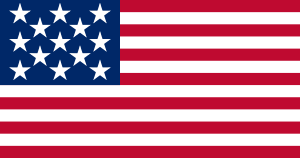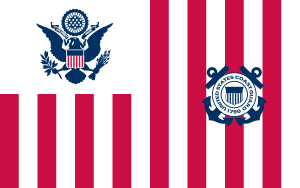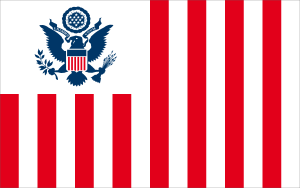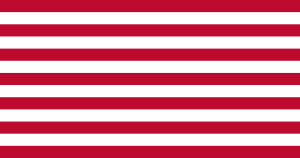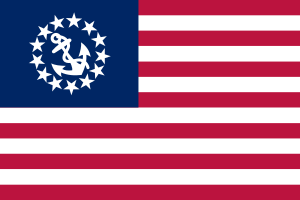Ensign of the United States facts for kids
 |
|
| Names | The Stars and Stripes, Old Glory |
|---|---|
| Use | National flag and ensign |
| Proportion | 10:19 |
| Adopted | June 14, 1777 (13-star version) July 4, 1960 (50-star version) |
| Design | Thirteen horizontal stripes alternating red and white; in the canton, 50 white stars on a blue field |
| Designed by | Unknown, possibly Francis Hopkinson |
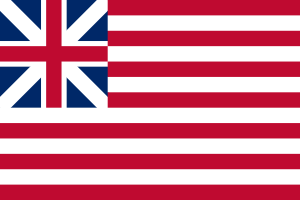
The ensign of the United States is the flag of the United States when it is used as a special flag on ships. An ensign is a type of maritime flag that shows what country a ship or boat belongs to. It usually flies from the back of a ship. U.S. Navy, Marine Corps, Coast Guard, and NOAA ships all fly the U.S. ensign.
Rules for ships around the world say that every ship needs to show its country's flag. This is especially true when ships are in waters far from home. U.S. military ships and government ships always fly the U.S. ensign. Smaller boats owned by U.S. citizens can also fly the U.S. ensign to show they are American.
Sometimes, U.S. pleasure boats use a special flag called the U.S. Yacht Ensign. This flag is often used instead of the national flag when boats are in U.S. waters. From 1848 to 1980, this flag was actually required for certain licensed yachts. Even today, many pleasure boats still use it because of this long tradition.
All U.S. boats should fly the regular national ensign when they are in international waters or waters outside the U.S.
Contents
History of U.S. Military Flags
The Grand Union Flag was the first unofficial U.S. naval ensign. It was first flown on December 3, 1775. This happened on the ship Alfred on the Delaware River. John Paul Jones, a famous naval officer, said he was the one who raised it.
The "Stars and Stripes" flag we know today was first chosen on June 14, 1777. The Continental Congress decided that the flag should have thirteen red and white stripes. It also said the flag should have thirteen white stars on a blue background. These stars represented a "new constellation" of states. As new states joined the country, the flag's design was updated with more stars.
Denmark and the Netherlands were the first countries to salute the Grand Union Flag. This happened in late 1776 in the Caribbean. The U.S. ship USS Andrew Doria received a salute from officials in Sint Eustatius in November 1776. This event is often called the "first salute" to the U.S. flag.
France was the first country to salute the "Stars and Stripes" flag. This happened on February 14, 1778. Captain John Paul Jones was commanding the ship USS Ranger at the time.
In the 1800s, naval ensigns were very large. The biggest one in 1870 was about 19 by 36 feet. By the early 1900s, warships looked very different from merchant ships. So, the ensigns started to get smaller. Today, the largest ensign for daily use on ships is about 5 by 9.5 feet.
During the 1800s, the U.S. Navy used a 13-star flag for its smaller boats. This flag was known as the "boat flag." The Navy started this practice in the 1850s. The reason for fewer stars was to make them easier to see on a smaller flag. Early submarines and destroyers also used these 13-star ensigns. In 1912, President William Howard Taft officially recognized the 13-star ensign. However, this practice ended in 1916 under President Woodrow Wilson. After that, all ensigns were supposed to have the full number of stars.
Coast Guard and Customs Flags
The United States Coast Guard flies a special ensign. This flag shows that they have the power to stop, board, and inspect ships. The U.S. Customs Service flies a very similar flag. However, the Customs flag does not have the Coast Guard's emblem on it.
These flags started from a flag created in 1799. It was designed for the United States Revenue Cutter Service. This service was the original form of the Coast Guard. In 1799, this flag was used as a national ensign on Revenue Cutters. It was also flown over Customs Houses on land.
In 1910, President William H. Taft made a change. He ordered that the plain flag continue to be flown over Customs Houses. But he told the Revenue Cutter Service to add their emblem to their flag. This helped tell the two branches apart.
When the U.S. Coast Guard was formed in 1915, they took over the flag with the emblem. The emblem was updated in 1927 and again in 1966. Today, the Coast Guard still uses this flag with the emblem. However, it is flown along with the regular U.S. national ensign, not by itself.
The design of the eagle and stars on both the Customs and Coast Guard flags was changed in 1951. This made them match the "arms of the United States," as was first planned in 1799.
Civilian Flags
Striped Merchant Ensign
We don't have a lot of information about early U.S. civilian flags. But there is some proof that during the American Revolution, some U.S. merchant ships flew a flag with 13 red and white stripes. These flags were similar to ones used by the Sons of Liberty. In the early years of the United States, flags were not yet standardized. This means there were many different versions, like the Serapis flag used by John Paul Jones.
Yacht Ensign
A special version of the national flag was created in 1848. It has a fouled anchor (an anchor with a rope wrapped around it) inside a circle of thirteen stars. This design is in the corner of the flag. This flag was made for licensed U.S. yachts. The New York Yacht Club suggested the design in 1849.
At first, licensed yachts were required to use this flag. It allowed them to travel between ports without having to go through customs every time. Over time, even unlicensed U.S. yachts started flying this flag. The U.S. Navy eventually recognized this practice for all U.S. yachts. In 1939, the Navy said that its ships should return a salute from a yacht flying the yacht ensign.
The law requiring licensed yachts to fly this ensign was removed in 1980. However, because it was used for so long by all U.S. yachts, it is still widely flown today. Many U.S. yachts and pleasure boats use it in U.S. waters. Some states, like Arkansas, Maryland, and Washington, even have rules that say the U.S. ensign and the U.S. Yacht Ensign can be used interchangeably on recreational boats in national waters.
However, if a U.S. recreational boat is in international or foreign waters, it should fly the regular national ensign.
Power Squadrons Ensign
The United States Power Squadrons (USPS) is a group that teaches people about boating safety and navigation. It was started in 1914. The USPS has about 45,000 members across the U.S. It is the largest non-profit boating group in America.
In 1914, the USPS adopted its own flag. This flag can be flown on a boat to show that the owner is a member of the organization. Even though it's called an "ensign," the U.S. government never officially recognized it as a national ensign. However, some smaller boats might fly this flag instead of the national ensign. This often happens if they don't have a mast or don't travel outside their home waters.
State Maritime Flags

In April 1776, the Massachusetts Naval Militia chose a special flag. It was a white flag with a green pine tree and the words "An Appeal to Heaven." In 1971, the words were removed. The flag was then named "the naval and maritime flag of the Commonwealth."
Maine also has its own special flag for ships, but it is rarely seen. It has a white background with a green pine tree. The tree has a seaman's anchor, and the words "MAINE" and "DIRIGO" around it. Dirigo is a Latin word that means "I direct" or "I lead." It is the state motto of Maine.
Massachusetts and Maine are the only two states with their own flags for use on the water. These flags are not "ensigns" in the true sense. They do not show national identity. Instead, they are special versions of the state flag for use on boats. The laws that created them call them "flags," not "ensigns."



